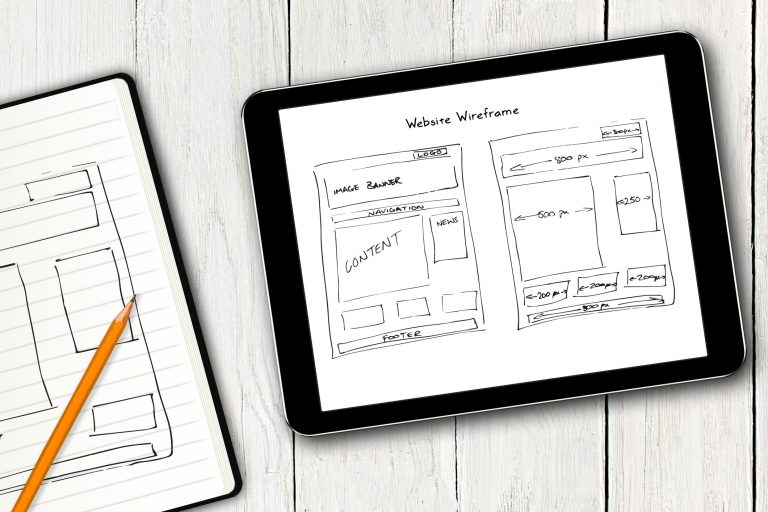Katie is our exceptional Lead Designer who possesses an innate passion for designing websites and creating captivating themes and aesthetics. Her unparalleled dedication to producing innovative solutions that address client needs and reshape user perceptions is truly commendable. Katie finds immense gratification in crafting tangible designs that leave a lasting impact. Equipped with a comprehensive university degree in Computer Management and Web-Based Studies, Katie brings a wealth of knowledge to the forefront of her role at Loop. Her educational background empowers her to leverage cutting-edge technologies and industry best practices to deliver exceptional design solutions. Katie’s expertise shines through her ability to revamp websites, logos, and brands, allowing clients to showcase their business in a fresh and illuminating manner. Her keen eye for detail and creative flair breathe new life into digital assets, providing a platform for clients to shine in their respective industries. In addition to her professional pursuits, Katie’s passion for baking serves as a testament to her creative nature and attention to detail. This dedication extends beyond her design work and fuels her ability to approach each project with meticulousness and care. Her ability to understand clients’ unique requirements and translate them into captivating designs has garnered her praise and established her as a trusted design partner. Katie’s professionalism and unwavering enthusiasm make her an invaluable asset to our team. Her expertise in website design, coupled with her dedication to delivering tangible results, sets her apart as a Lead Designer. Clients can expect nothing short of exceptional designs that elevate their brand, captivate their audience, and drive success.
Posted on 16/05/2023 by Katie Manning
The Importance of A/B Testing
In today’s digital environment competition is fierce and user expectations are constantly evolving, businesses are in a perpetual quest for growth and constant optimisation. It is no longer enough to simply have an online presence; success hinges upon delivering exceptional user experiences, driving conversions, and maximising return on investment. Enter A/B testing – a game-changing methodology that has revolutionised the way brands make data-driven decisions to propel their online endeavours forward.
Whether you’re a seasoned marketer looking to optimise your campaigns or a web developer aiming to enhance user experiences, this blog will equip you with the knowledge and insights needed to harness the power of A/B testing and unlock your business’s full potential.
What is A/B Testing?
A/B testing is a research method that allows you to compare two variations of an item or element to see which is more effective to implement. The methodology involves supplying target audiences with two variants at random. For example, two different versions of a webpage, page elements, or email marketing. Showing two variations to different segments of your site visitors determines which option is most effective and likely to achieve your goals.
Testing variations of your marketing tactics and actions give you clear evidence of what is working and what isn’t. The type of content you publish, search engine optimisation, and email marketing all benefit from A/B testing.
A/B testing saves marketers time as it highlights relevant and effective actions. It also saves on costs as you invest in methods that provide the best opportunity for success. 58% of marketers are using A/B testing to increase conversion rate optimisation.
Why is A/B Testing Important?
A/B testing removes any guesswork from user experience and website optimisation. Before the test, establish your hypothesis, what you think the result will be. Then from the data that’s been generated analyse the results to make smarter decisions more likely to achieve your goals. As part of the methodology, A is the control subject, the original variable. Whereas, B is the new version that you’re testing to see if it’s more effective.
Once the test has concluded, check to see whether your hypothesis was correct. Making a data-backed decision is a much more efficient way to implement marketing actions. The metrics for success to measure during an A/B test varies depending on your goals.
Determining the winner from A/B testing is a unique process each time. The measurement for success may be the click-through rate of a call to action. While for an eCommerce site success could be which product description leads to more sales conversions. There are many ways to use A/B testing to benefit your marketing efforts, such as website optimisation and increasing ROI.

The Benefits Of A/B Testing
The biggest reason to implement A/B testing is it provides relevant and valuable user insights. Generating both qualitative and quantitative data to analyse and make decisions based on gives marketers the best chance of success. Use a mix of research to identify whether your original hypothesis was correct.
Having more data, both qualitative and quantitative, and a clear and measurable hypothesis gives your A/B test the best chance to produce valuable results. Depending on what you’re testing, the A/B methods provide insight into the user experience, pain points, engagement, new features, and what drives conversations.
Improve Conversion Rates
This form of testing allows you to measure what drives conversion rates. Create a variation of CTAs with different text locations, the language used, and the visual design. Whatever the goal of the call to action is, A/B testing allows you to measure which variation is more effective. Marketers can also analyse the generated data and cherry-pick the most successful elements.
Drive Website Traffic
Blog posts, landing pages, and other web pages all want and need to attract visitors. Test variations of these web pages – change the copy/content, titles, and imagery, for example – to see which is more effective at driving traffic to the website. Making decisions based on the data also helps marketers to attract relevant visitors that are more likely to convert into a lead or sale.
Reduce Bounce Rates
One of the biggest pain points for marketers is users bouncing from a website quickly. Testing variations of a webpage with a high bounce rate provides evidence of why users aren’t engaging with the on-page content. Is it because the content isn’t relevant to them? Is it not answering their questions fast enough? Write fresh introductions and create new on-page designs to test what reduces bounce rates and increases dwell time on a webpage.
Increase ROI
A/B testing provides marketers with solutions on how to solve conversion problems on websites. Making data-based decisions allows you to invest in marketing efforts likely to deliver results. This reduces spend on failing strategies, while also helping you to increase conversions and sales.
Redesign Website
During a website redesign, A/B testing provides user insights into design ideas. Even for minor changes, you want to implement, test them and measure if it’s a beneficial change to make for the business and the user experience. After a new site goes live continue to conduct A/B testing of page elements. This ensures that you’ve created the version of a website most likely to achieve your goals and provide value to site visitors.

What’s The Difference Between A/B & Split Testing
The two terms are often used interchangeably; however, there are some differences between split and A/B testing. A/B testing refers to the two variations that are being compared. This could be either an entire webpage or subtle tweaks to a website, for example. While split testing is the traffic that’s redirected between the variations.
What Can You A/B Test?
The beauty of A/B testing lies in its versatility. You can conduct experiments on almost any element or feature of your website that has the potential to impact user behaviour and outcomes. From the smallest details like button colours to major design overhauls, the possibilities are endless. This iterative process enables you to refine and enhance your website, ensuring that it resonates better with your target audience and achieves your business objectives.
By systematically testing different variations of a webpage, you gain valuable insights into user preferences and behaviour. It enables you to understand what resonates with your audience, what drives engagement, and ultimately, what generates the desired actions. This data-driven approach empowers you to make informed decisions, optimise conversion rates, and create a seamless user experience.
Headings
Testing catchier heading tags that may attract more viewers or a higher search volume in search engines will help a lot in getting higher rankings for your page and drawing in more users. The same applies to your subheadings – having relevant subheaders is key as it guides visitors to a specific section on the page.
Body Content
Changing your normal text on your pages to more relevant information about what your business does, and relevant industry-related content can help a lot by attracting more relevant visitors to your site. This is because they can find the information faster, satisfying the reason they came to your site. If you add internal links to your text they will be more inclined to explore your website and stay in a session longer.
Testimonials
New viewers on your site have never heard of you – so you should aim to build trust with anyone coming onto your site and there is no better way than showing previous customer/user reviews on your site. Make these reviews on each page if you can even if it’s just one or two. Use reviews related to the page and highlight these to build this trust.
Call to Actions Content
You should be using a call to action on every page, and use A/B testing to compare how changing the text influences its success. Sometimes on pages, there isn’t enough space for a big shiny button, why not use hyperlink text like this to bring people across to new pages. These hyperlinks will stand out but don’t take up much room so are easy to implement into any written content. They are also good for Google’s algorithm using internal links.
Call to Action Buttons
Buttons can work better than just normal text links as they attract more attention because they’re usually big and colourful and placed with a lot of white space around them so that they stand out more than just an ordinary link. A/B testing can help determine whether to use buttons or text and the style and position that works best. This could be at the bottom of the page, a contact button that’s constantly on the page to draw attention. Use CTA’s on every page to try and boost conversion rates among users.
Images
Experiment with the images you use on different pages. Use stock, and cartoony and see which fits in with your brand and brand image. You can try these over a period and see how your sessions are influenced.
Content Near The Fold
The fold is the portion of the web page that’s visible in the browser when the page initially loads. Having eye-catching photos and/or relevant content near that fold makes users more intrigued and want to stay on your site for longer. Use a heat map to see where people have the most interactions already and put photos in those sections or outside. Make them scannable as most users don’t read and look at everything on your site. Use the photos to draw attention to users and keep them on your site.
How To Carry Out A/B Testing
1. Choose The Variable You Want To Test
Of course, there will likely be several variables you want to test. However, isolate one independent variable to measure its performance. Otherwise, it will be difficult to understand which change you’ve made is driving success.
2. Establish Your Goal
With every A/B test, focus on a primary metric and establish it before beginning the test. Understanding what you want to achieve makes analysing the data easier and the implementation of the test more likely to produce effective results.
3. Split The Traffic Equally
To generate conclusive results, split the traffic between the two variables equally. This improves the data you’ve generated and makes the results more relevant. Once the test has concluded, you can measure the outcome and use it to make effective decisions as a marketer.
Conversion Rate Optimisation at Loop Digital
At Loop Digital, we implement a/b testing to ensure we achieve optimal results for our client partners as part of our CRO service. Using testing as part of our wider marketing efforts, allows our experienced team to measure our actions and deliver consistent successes. As we make data-backed decisions, you can trust our processes will benefit you. Get started on your journey today by getting in touch with our team to discuss your digital marketing strategy.
Looking for your next opportunity?
Digital marketing careers
We’re always on the lookout for talented individuals to join our ever growing team. If you think you’d be a great match for Loop Digital, we’d love to hear from you.

Join 300+ business owners getting weekly growth strategies - subscribe now.
"*" indicates required fields






